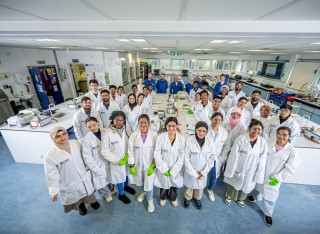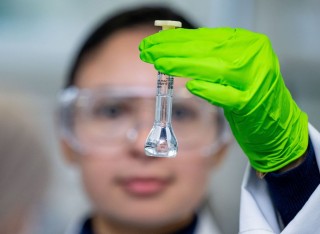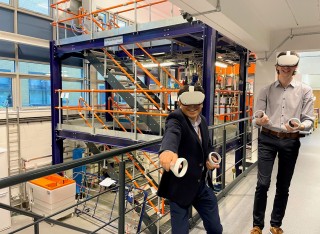
Professor Adrian Dobbs
Academic and research departments
School of Chemistry and Chemical Engineering, Health and food, Energy and materials.About
Biography
Adrian studied Chemistry at King's College London, obtaining his B.Sc. (1st Class Honours) in 1992 and PhD in 1996, the latter under the supervision of Professor Keith Jones and working on the development of heteroaryl radicals in synthesis (sponsored by SmithKline Beecham). He was awarded a Royal Society European Research Exchange Fellowship for post-doctoral work with Professor Istvan Markó at the Université catholique de Louvain, in Louvain-la-Neuve, Belgium between 1996-8 (working towards the total synthesis of okadaic acid).
On his return to the UK, Adrian joined the process development group of GSK (Tonbridge, Kent) before leaving to take up his first academic post at the Open University in 1999. A move to the University of Exeter soon followed, where independent research really commenced and he also filled a number of Department academic administrative roles. Subsequently in 2005, Adrian was appointed as Senior Lecturer in Organic Chemistry at Queen Mary University of London, where he was also Senior Admissions Tutor and responsible for industrial placements. He moved to the Chair of Organic and Medicinal Chemistry at the University of Greenwich in January 2013 and was Head of the newly formed School of Science between 2018-2022. He joined the University of Surrey as Had of the new School of Chemistry & Chemical Engineering in March 2022.
Away from work, Adrian is a very keen Crystal Palace supporter and is an accomplished pianist and organist, regularly performing on both instruments and also leading, conducting and rehearsing several orchestras and choirs.
University roles and responsibilities
- Head of School of Chemistry & Chemical Engineering
Affiliations and memberships
Chartered Chemist
News
ResearchResearch interests
Research, collaboration and engagement
The philosophy of the research group is the development of new synthetic methodologies for application in total synthesis and analogue production of a variety of complex natural products, with the long-term view of probing the biological pathways and the mechanisms of disease.
At present, the primary focus of the group is the development of new synthetic methodology for the asymmetric synthesis of a variety of heterocyclic systems. The majority of work has involved either Lewis acid mediated reactions of organosilicon compounds, various aspects of organofluorine chemistry or radical cyclisation reactions. The methodologies developed by the group have been applied to the total synthesis of several biologically active molecules, most notably (+)- and (-)-solenopsin A, (±)-Epi-dihydropinidine, racemic & enantiomerically pure Civet, (±)-Ritalin and the first published synthesis of (+)- and (-)-irciniasulfonic acid. Funding has been obtained from a diverse variety of sources, including Research Councils (EPSRC), the EU and the pharmaceutical industry (GSK, Pfizer and AstraZeneca).
More recently, several collaborative interdisciplinary projects have been initiated in medicinal and biological chemistry: to prepare steroid-based compounds to investigate both oestrogen and glucocorticoid receptors (with Professor Gavin Vinson and Dr John Puddefoot, QMUL); to prepare novel nitro-containing heteroaromatics as potential anti-parasitic agents (with Dr Shane Wilkinson, QMUL), and to investigate the total synthesis and biological activity of JBIR-23, an anti-mesothelioma compound (with Dr Peter Szlosarek, Bart's Hospital) and funded by the June Hancock Mesothelioma Research Fund (JHMRF). He is particularly passionate about this latter project and has spoken at many public engagement meetings concerning the dangers of asbestos, and asbestos-induced lung cancers in particular.
Professor Dobbs is a regular speaker, having given numerous university research colloquia within the UK and EU (Ireland, Sweden, France, Belgium, Poland) and at international synthesis/heterocyclic chemistry conferences.
Professor Dobbs welcomes enquiries at any time from potential collaborators regarding these or future projects.
Current research group
- 2 Postdoctoral research fellow
- 5 PhD students
Indicators of esteem
Director University Alliance DTA in 'Applied Biosciences for Health' 2019-2022
University Alliance 'Professionals Prize', 2021
Inspirational Member Prize and Award, Royal Society of Chemistry, 2015
As an undergraduate, recipient of the following awards and prizes:
Samuel Smiles Prize, 1991
Style Silver Medal and Prize, 1991
Sambrooke Exhibition Prize, 1990
Style Bronze Medal and Prize, 1990
Research interests
Research, collaboration and engagement
The philosophy of the research group is the development of new synthetic methodologies for application in total synthesis and analogue production of a variety of complex natural products, with the long-term view of probing the biological pathways and the mechanisms of disease.
At present, the primary focus of the group is the development of new synthetic methodology for the asymmetric synthesis of a variety of heterocyclic systems. The majority of work has involved either Lewis acid mediated reactions of organosilicon compounds, various aspects of organofluorine chemistry or radical cyclisation reactions. The methodologies developed by the group have been applied to the total synthesis of several biologically active molecules, most notably (+)- and (-)-solenopsin A, (±)-Epi-dihydropinidine, racemic & enantiomerically pure Civet, (±)-Ritalin and the first published synthesis of (+)- and (-)-irciniasulfonic acid. Funding has been obtained from a diverse variety of sources, including Research Councils (EPSRC), the EU and the pharmaceutical industry (GSK, Pfizer and AstraZeneca).
More recently, several collaborative interdisciplinary projects have been initiated in medicinal and biological chemistry: to prepare steroid-based compounds to investigate both oestrogen and glucocorticoid receptors (with Professor Gavin Vinson and Dr John Puddefoot, QMUL); to prepare novel nitro-containing heteroaromatics as potential anti-parasitic agents (with Dr Shane Wilkinson, QMUL), and to investigate the total synthesis and biological activity of JBIR-23, an anti-mesothelioma compound (with Dr Peter Szlosarek, Bart's Hospital) and funded by the June Hancock Mesothelioma Research Fund (JHMRF). He is particularly passionate about this latter project and has spoken at many public engagement meetings concerning the dangers of asbestos, and asbestos-induced lung cancers in particular.
Professor Dobbs is a regular speaker, having given numerous university research colloquia within the UK and EU (Ireland, Sweden, France, Belgium, Poland) and at international synthesis/heterocyclic chemistry conferences.
Professor Dobbs welcomes enquiries at any time from potential collaborators regarding these or future projects.
Current research group
- 2 Postdoctoral research fellow
- 5 PhD students
Indicators of esteem
Director University Alliance DTA in 'Applied Biosciences for Health' 2019-2022
University Alliance 'Professionals Prize', 2021
Inspirational Member Prize and Award, Royal Society of Chemistry, 2015
As an undergraduate, recipient of the following awards and prizes:
Samuel Smiles Prize, 1991
Style Silver Medal and Prize, 1991
Sambrooke Exhibition Prize, 1990
Style Bronze Medal and Prize, 1990
Publications
The use of donor-only silylmethylcyclopropanes in the Lewis acid promoted reaction with aldehydes to generate 2,5-disubstituted tetrahydrofurans is described. The diastereoselectivity obtained in the product is very dependent upon the temperature of the reaction. (C) 2011 Elsevier Ltd. All rights reserved.
The cyclisation of pyridine radicals derived from 2-bromo-N-alkyl pyridinium salts is described. The subsequent hydrogenation of the pyridinium salts is shown to give both the indolizidine and quinolizidine skeletons. The synthesis of a range of pyridinium radical precursors is described together with their subsequent radical cyclisation and hydrogenation.
The synthesis of 2,5-disubstituted tetrahydrofurans from donor silylmethylcyclopropanes (without bearing an acceptor function) is described. Their further elaboration via a wide range of synthetic transformations is presented to highlight the potential of this method and the resulting THFs as potential scaffolds for diversity-oriented synthesis. (C) 2012 Elsevier Ltd. All rights reserved.
A range of silicon-based tethers and promoters have been investigated for use in the development of a silyl-tethered Pauson-Khand reaction.
While developing new variations of the Prins cyclisation reaction, the effect of the choice of Lewis acid on the outcome of the reaction and the product(s) has been investigated, yielding hitherto unseen dihydropyran products in the Prins cyclisation reaction of homoallylic alcohols, and two new modifications of the reaction: the triflate-trapped Prins adduct and the Mukaiyama–Aldol–silyl-Prins reaction. Two of these methods are employed in two complementary total syntheses of the important perfumery compound, (±)-Civet. [Display omitted]
Reaction of 4-trimethylsilyl-3-buten-1-ols with aldehydes under mild Lewis acid conditions gives substituted dihydropyrans in excellent yields and with good stereocontrol. Graphic
The silyl-Prins and aza-silyl-Prins reactions have been employed for the preparation of 6-CF3-substituted dihydropyrans and 6-CF3-substituted tetrahydropyridines. The product heterocycles have been further elaborated to a number of products, including CF3-substituted pipecolates and hydroxylated pyrans and piperidines. (C) 2007 Elsevier Ltd. All rights reserved.
Graphic The fluorous biphasic system has become increasingly popular amongst the academic community as a phase separation and immobilisation technique. It has revolutionised both the synthetic organic and catalytic communities. However, the fluorous biphasic system has still to be fully embraced by the industrial sector. The major developments in fluorous chemistry are reviewed, with a particular emphasis on potential industrial applications.
The synthesis of a fluorous analogue of diethyl azodicarboxylate (DEAD) is described and preliminary results for its use in the Mitsunobu reaction given. Use of fluorous extraction methods have shown that chromatography is not necessary for reaction purification. Graphic
Abstract A flexible and concise first total synthesis of the irciniasulfonic acids is reported.
The syntheses and radical cyclisations of 2-bromoindoles carrying an unsaturated N-alkyl group is described. The synthesis of a range of indole radical precursors is described together with their subsequent radical cyclisation.
A simple methodology for the stereocontrolled synthesis of dihydropyrans has been established. The trans-dioxadecalin 22, featuring the middle portion of okadaic acid, has been efficiently assembled using this strategy. trans-Dioxadecalin 2, a model for the middle portion of okadaic acid, has been efficiently assembled using an extension of the ISMS cyclisation methodology.
The front cover illustrates a novel photochemical cyclisation to prepare spiroketals and which was utilised to prepare a number of bee pheromone natural products. Details can be found in Research Article by Adrian P. Dobbs, and co‐workers (J. Trevorrow, N. Sibanda, A. O'Kearney‐McMullan, L. M. Potucka, A. P. Dobbs, Adv. Synth. Catal. 2024, 366, 4694–4701; DOI: 10.1002/adsc.202400393)
The development of a Lewis acid-promoted aza-Prins reaction to form piperidines and pyrrolidines is described. Indium trichloride has been found to be a highly successful and mild Lewis acid for promoting this reaction. A thorough mechanistic investigation is described, including the factors that influence the formation of the 5- or 6-membered ring product(s).
The synthesis of a range of fluorinated heterocycles is described via a Lewis acid-mediated Prins-type cyclisation.
The design and development of the first asymmetric aza-silyl-Prins reaction is reported, giving rise to valuable and diverse piperidines and pipecolic acid derivatives in both high yields and as single enantiomers. The creation of a novel chiral auxiliary-homoallylic amine for the aza-silyl-Prins reaction is essential to its success.
The synthesis and radical cyclisations of 2-bromoindoles carrying an unsaturated N-alkyl group is described. The synthesis of a range of indole radical precursors is described together with their subsequent radical cyclisation.
The Cover Feature shows the structures of important extractable and leachable components of elastomeric closures; the type used by the pharmaceutical industry in injection systems such as stoppers and caps. Their structures have been confirmed by de novo synthesis for the first time, starting from isophorone and employing novel organosulfur chemistry. The authors thank Jonathan Stroulger for the design of the cover. More information can be found in the Full Paper by A. Dobbs et al.
Abstract Expedient syntheses of (-)-solenopsin A and (+)-EPI-dihydropinidine are reported, the key step in both being the one-pot multicomponent aza-silyl-Prins condensation reaction to yield a TRANS dihydropyridine.
The synthesis of two light-fluorous TEMPO derivatives is reported, along with their application in oxidation reactions.
A new electrochemical methodology has been developed for the preparation of a wide variety of functionalised orthoesters under mild and green conditions from easily accessible dithiane derivatives. The new methodology also offers an unprecedented way to access tri(fluorinated) orthoesters, a class of compound that has never been studied before. This provides the community with a rapid and general method to prepare libraries of functionalised orthoesters from simple and readily available starting materials.
The synthesis of two light-fluorous TEMPO derivatives is reported, along with their fluorous-organic solvent partition coefficients and their ESR spectra. Applications of the fluorous-TEMPO reagents in oxidation reactions and as radical traps are discussed. [Display omitted]
The synthesis and radical cyclisation of 7-bromoindoles carrying an unsaturated N-alkyl group is described. The synthesis of a range of indole radical precursors is described together with their subsequent radical cyclisation.
We report a new electrochemical supporting-electrolyte-free method for synthesizing ureas, carbamates, and thiocarbamates via the oxidation of oxamic acids. This simple, practical, and phosgene-free route includes the generation of an isocyanate intermediate in situ via anodic decarboxylation of an oxamic acid in the presence of an organic base, followed by the one-pot addition of suitable nucleophiles to afford the corresponding ureas, carbamates, and thiocarbamates. This procedure is applicable to different amines, alcohols, and thiols. Furthermore, when single-pass continuous electrochemical flow conditions were used and this reaction was run in a carbon graphite Cgr/Cgr flow cell, urea compounds could be obtained in high yields within a residence time of 6 min, unlocking access to substrates that were inaccessible under batch conditions while being easily scalable.
The spiroketal moiety is an important substructure within many biological natural products. One method to access them is via the oxidative cyclisation of a pendant hydroxyl group on to a pre-formed pyran. However access to such precursors has hitherto been challenging and requires multistep syntheses frequently with considerable protecting group manipulation. Herein we report a novel and high yielding method for the preparation of hydroxydi- and hydroxytetra-hydropyrans, as spiroketal precursors, utilizing a novel double-Prins cyclisation approach.
A two-step transition metal-free methodology for the C(sp(3))-C(sp(3)) functionalisation of saturated N-heterocyclic systems is disclosed. First, aminal derivatives are generated through the anodic oxidation of readily accessible carboxylic acids. Then, in the presence of BF3 center dot OEt2, iminium ions are unmasked and rapidly alkylated by organozinc reagents under flow conditions. Secondary, tertiary and quaternary carbon centers have been successfully assembled using this methodology. Such an approach is especially relevant to drug discovery since it increases C(sp(3))-functionalities rapidly within a molecular framework. As proof of concept, our methodology was applied to derivatization of peptides and an API.
The aza-Prins reaction is a widely employed and highly efficient method for the preparation of saturated nitrogen-containing heterocycles. Its major drawback has always been a lack of diastereoselectivity and the formation of racemic products. Herein, we address these problems and report, for the first time, the synthesis of both diastereomerically and enantiopure multiply substituted piperidines via the aza-Prins reaction. This method is widely applicable for natural product synthesis and is exemplified here by the synthesis of enantiopure pipecolic acid derivatives.
A new electrochemical methodology has been developed for the generation of oxycarbonyl radicals under mild and green conditions from readily available hemioxalate salts. Mono- and multi-functionalised γ-butyrolactones were synthesised through exo-cyclisation of these oxycarbonyl radicals with an alkene, followed by the sp3–sp3 capture of the newly formed carbon-centred radical. The synthesis of functionalised valerolactone derivatives was also achieved, demonstrating the versatility of the newly developed methodology. This represents a viable synthetic route towards pharmaceutically important fragments and further demonstrates the practicality of electrosynthesis as a green and economical method to activate small organic molecules.
A new electrochemical methodology has been developed for the preparation of a wide variety of functionalized orthoesters under mild and green conditions from easily accessible dithiane derivatives. The new methodology also offers an unprecedented way to access tri(fluorinated) orthoesters, a class of compound that has never been studied before. This provides the community with a rapid and general method to prepare libraries of functionalized orthoesters from simple and readily available starting materials.
Saturated nitrogen-containing heterocycles are the basis of a plethora of natural products, including alkaloids and aza-sugars, and a recent survey also demonstrated that the piperidine ring is the most abundant nitrogen-containing heterocycle in FDA-approved pharmaceutically active and commercially available drugs, being found in 72 drugs. The aza-Prins and related reactions have emerged as a rapid and highly efficient method for the preparation of 6-membered nitrogen-containing heterocycles. This chapter reviews recent developments in the aza-Prins reaction, particularly focussing on reports since 2000.
The growing impetus to develop greener and more cost-efficient synthetic methods has prompted chemists to look for new ways to activate small organic molecules. Among them, electrosynthesis is one of the greenest and cheapest since it is possible to perform redox reactions without the need for any chemical reagents. Even though electrosynthesis is on the verge of a resurgence, it is far from being a new discipline. In fact, organic electrosynthesis was popularised by Manual Baizer in the early 60s while working at Monsanto. In this article, we will review the major, as well as the most recent, achievements in industrial organic electrosynthesis.
A detailed study on the synthesis and reactions of silylmethylcyclopropanes is reported. In their simplest form, these donor-only cyclopropanes undergo Lewis acid promoted reaction to give either cis- or trans-tetrahydrofurans, with the selectivity being reaction condition-dependant. The adducts themselves are demonstrated to be an important scaffold for structural diversification. The combination of a silyl-donor group in a donor-acceptor cyclopropane with novel acceptor groups is also discussed. [Display omitted]
The first total synthesis of an important C13 butyl rubber oligomer is reported. The structure of the oligomer, which is an important and potentially toxic extractable and leachable component of elastomeric closures, is confirmed by synthesis for the first time. The method described is scalable, making large quantities of the oligomer available for the first time for AMES toxicity studies. The challenging synthesis commences with isophorone and the key steps of the synthesis involve the development of highly novel dithoacetal chemistry, cuprate addition and Tebbe olefination. The first total synthesis of important C13 butyl rubber oligomers is reported. The structure of the oligomer, which is an important extractable and leachable component of elastomeric closures, is confirmed for the first time. The 10‐step synthetic sequence starting from isophorone is robust and scalable, making large quantities of the oligomer available for the first time.
We describe the development of a novel low-cost small-footprint 3D-printed electrosynthesis continuous flow cell system that was designed and adapted to fit a commercially available Electrasyn 2.0. The utility and effectiveness of the combined flow/electrochemistry system over the batch process was demonstrated in the development of an improved and supporting-electrolyte-free version of our anodic methoxymethylation of alcohols.
This chapter will discuss the addition reactions of the hydrides of the Group IV elements to carbon–carbon double and triple bonds, namely hydrosilylation, hydrostannylation, hydrogermylation, and hydroplumbylation reactions of alkynes and alkenes.\ud Although there is no corresponding chapter in the first edition of Comprehensive Organic Synthesis, the material presented here will follow on from Chapters 3.9 and 3.12 and the reader is referred back to these.
A new electrochemical method for the preparation of isocyanides from easily accessible aminotetrazole derivatives has been developed, which tolerates an unprecedented range of functional groups. The use of chemical, rather than electrochemical, oxidation to afford isocyanides was also demonstrated, which provides access to these compounds for those without electrosynthesis equipment. The practicality of scale-up using flow electrochemistry has been demonstrated, in addition to the possibility of using electrochemically generated isocyanides in further reactions.
The first detailed studies of intramolecular aza-Prins and aza-silyl-Prins reactions, starting from acyclic materials, are reported. The methods allow rapid and flexible access toward an array of [6,5] and [6,6] aza-bicycles, which form the core skeletons of various alkaloids. On the basis of our findings on the aza-Prins and aza-silyl-Prins cyclizations, herein we present simple protocols for the intramolecular preparation of the azabicyclic cores of the indolizidines and quinolizidines using a one-pot cascade process of N-acyliminium ion formation followed by aza-Prins cyclization and either elimination or carbocation trapping. It is possible to introduce a range of different substituents into the heterocycles through a judicial choice of Lewis acid and solvent(s), with halo-, phenyl-, and amido-substituted azabicyclic products all being accessed through these highly diastereoselective processes.
A novel carbonylative approach to the synthesis of functionalized 1H-benzo[d]imidazo[1,2-a]imidazoles is presented. The method consists of the oxidative aminocarbonylation of N-substituted-1-(prop-2-yn-1-yl)-1H-benzo[d]imidazol-2-amines, carried out in the presence of secondary nucleophilic amines, to give the corresponding alkynylamide intermediates, followed by in situ conjugated addition and double-bond isomerization, to give 2-(1-alkyl-1H-benzo[d]imidazo[1,2-a]imidazol-2-yl)acetamides. Products were obtained in good to excellent yields (64-96%) and high turnover numbers (192-288 mol of product per mol of catalyst) under relatively mild conditions (100 °C under 20 atm of a 4:1 mixture of CO-air), using a simple catalytic system, consisting of PdI (0.33 mol %) in conjunction with KI (0.33 equiv).


